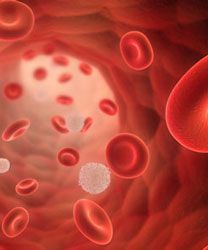Article
IKZF1 Deletions Predict Poor Prognosis in Pediatric ALL
Author(s):
IKZF1 deletions that co-occurred with deletions in CDKN2A, CDKN2B, PAX5, or PAR1 in the absence of ERG deletion (IKZF1plus) were associated with a dramatically reduced prognosis in pediatric patients with B-cell precursor ALL.
mcl

IKZF1 deletions that co-occurred with deletions in CDKN2A, CDKN2B, PAX5, or PAR1 in the absence of ERG deletion (IKZF1plus) were associated with a dramatically reduced prognosis in pediatric patients with B-cell precursor (BCP) acute lymphoblastic leukemia (ALL).
Investigators on the international, multicenter AIEOP-BFM ALL 2000 trial previously established minimal residual disease (MRD) risk as the strongest prognostic factor among this cohort. When investigators categorized patients by MRD status, 5-year event-free survival (EFS) was just 30 ± 14% in high-risk IKZF1plus patients compared with 94 ± 5% in those with standard risk and 40 ± 10% in intermediate-risk patients.
The corresponding 5-year cumulative incidences of relapse were 6 ± 6%, 60 ± 10%, and 60 ± 17%, respectively (P ≤.001).
Researchers evaluated all 991 children with BCP ALL diagnosed from August 1999 to May 2009 who were enrolled at clinics in Italy and Germany. Patients were stratified into standard-, intermediate-, and high-risk groups based on MRD analysis and required 2 MRD targets with sensitivities of ≤1 × 10−4.
All patients underwent 7 days of prephase treatment with prednisone and 1 intrathecal dose of methotrexate, followed by induction phase IA and induction consolidation phase IB. From day 8, patients were randomly assigned to continue steroid treatment with either 60 mg/m2 of prednisone daily or 10 mg/m2 of dexamethasone daily until day 28 with subsequent tapering of dose in 1 more week.
MRD standard-risk patients were MRD negative on treatment days 33 and 78, and MRD high-risk patients had residual disease of ≥5 × 10−4 on treatment day 78. All remaining patients were considered MRD intermediate risk.
In outcome analysis, IKZF1plus was associated with a 5-year EFS of 53 ± 6% compared with 79 ± 5% for patients with IKZF1 deletion or 87 ± 1% in patients who lacked any IKZF1 deletion (IKZF1plus vs no IKZF1 deletion, P ≤.001).
Multivariable analyses—including factors such as IZKF1 deletion, MRD risk status, and slow early MRD response—showed that IKZF1plus had the largest hazard ratio for relapse (HR, 4.00; 95 CI, 1.91-8.37; P <.001), which investigators found underscored the strongest prognostic effect.
“We have integrated molecular genetic data with MRD data into a single combined classification that will be used to refine treatment stratification and guide innovative but still costly therapeutic applications in our upcoming trial AIEOP-BFM ALL 2017 for frontline treatment of pediatric ALL,” Martin Stanulla, MD, department of Pediatric Hematology and Oncology, Hannover Medical School, and colleagues wrote.
“To go beyond current risk stratification strategies, additional research on the biologic basis of our observations is needed and will be helpful in guiding the development of more-targeted and less-toxic innovative therapies for children and adolescents with ALL,” added Stanulla et al.
Investigators used an independent cohort of 417 patients treated in AIEOP-BFM ALL 2000 who had the necessary genetic information available for confirmation of the negative prognostic effect of IKZF1plus. The 5-year EFS observed for IKZF1plus was 44 ± 12% compared with 74 ± 7% for IKZF1 deletions or 85 ± 2% for no IKZF1 deletions (IKZF1plus vs no IKZF1 deletion, P ≤.001). The respective 5-year cumulative incidences of relapse were 44 ± 12%, 24 ± 7%, and 13 ± 2% (IKZF1plus vs no IKZF1 deletion, P = .001).
“Similar to the observation cohort, multivariable analyses in the validation cohort demonstrated independence of IKZF1plus,” wrote Stanulla et al.
Stanulla M, Dagdan E. Zaliova M, et al. IKZF1plus defines a new minimal residual disease—dependent very-poor prognostic profile in pediatric b-cell precursor acute lymphoblastic leukemia [published online March 2, 2018]. J Clin Oncol. doi: 10.1200/JCO.2017.74.3617.








